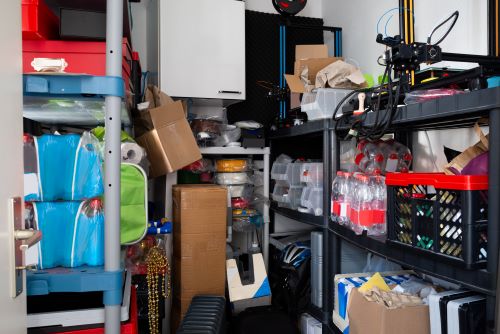
Every church seems to lack one thing – storage! So, it’s no surprise the enticement to place things in an otherwise seemingly empty room which electrical/mechanical rooms are initially designed to be. The only problem – electrical rooms should never double as a storage closet but they often are. For the safety of your facility and possibly the safety of others, may we challenge you to do the following?
Initial Safety Planning:
- Maintain Proper Clearance – While it’s best not to store anything in an electrical room, if you must, store items – especially combustibles – at least 3 feet away from the front and sides of electrical panels, electrical equipment and ventilation vents and openings. While OSHA regulations do not generally extend to non-profits, they can still be considered a standard of care and so it’s worth of noting that OSHA states similar spacing requirements.
- Establish boundaries with floor marking – Marking off the boundaries with visible floor markings serves as a great reminder. The bright colors and contrast of striped hazard tape makes it easy to see from a distance and it’s quite affordable; a 100-foot roll is available through Amazon for about $10.
- Floor signs – You may also want to use large, durable floor signs to alert others to the electrical panels and serve as an additional reminder to keep the area clear.
Why Is It Important To Maintain Proper Clearances Around Electrical Panels?
- Potential fire hazard – Electrical panels can become fire hazards when they can no longer handle the voltage flowing through them. Their reasons for failing can be several. The most common is simply they get old. They can also become damaged, be subject to corrosion or have faulty installation, the latter often by well-meaning volunteers but not licensed electricians. These faults can compromise the effectiveness of electrical panels and turn them into fire hazards. Side Note: If you happen to have a Federal Pacific panel (typically installed from the 1950’s to the 1980’s with the prime dates seeming to be in the 1960’s), these panels are extremely unsafe and should be replaced immediately. They are well known and documented to not throw the breaker when there is a short circuit or circuit overload.
- Shutting down equipment during an incident—In the event of an equipment malfunction or similar safety incident, workers must be able to access electrical panels. This allows them to easily shut off potentially harmful equipment and secure the work area. This is particularly important for equipment that does not feature an emergency shut-off switch.
- Repairing and maintaining electrical panels—When panels are obstructed, they are more difficult to access and maintain. If a worker is servicing an electrical panel and has to contend with nearby obstacles, they are more likely to make a mistake or injure themselves. This risk is compounded if the worker is working on live electrical components.
- Storing materials and performing work—As previously noted, the storing of hazardous or combustible materials too close to electrical panels run the risk of starting fires. What’s more, when employees perform work nearby an electrical panel, they could accidently hit or damage it, creating potential electrocution hazards.
Even if you establish these protocols, you need to check these rooms often because things have a funny way of sneaking in there. Make sure your staff is well versed on the guidelines, lock the doors as necessary but also make sure the means to open them is readily available.
